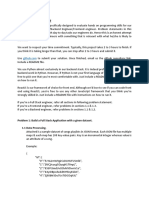0% found this document useful (0 votes)
16 views7 pagesInterview Based
The document outlines various technical approaches for building and managing software applications, including error handling in Node.js and Express, dynamic product filtering in React, finding unique elements in arrays using XOR, designing scalable dashboards for IoT devices, securely handling file uploads, improving rendering performance in React apps, designing relational database tables for e-commerce, and deploying full stack applications. Each section provides concise explanations of methodologies, best practices, and technologies applicable to the respective challenges. The content emphasizes efficiency, security, and scalability across different software development scenarios.
Uploaded by
er.sheikh.mursalinCopyright
© © All Rights Reserved
We take content rights seriously. If you suspect this is your content, claim it here.
Available Formats
Download as TXT, PDF, TXT or read online on Scribd
0% found this document useful (0 votes)
16 views7 pagesInterview Based
The document outlines various technical approaches for building and managing software applications, including error handling in Node.js and Express, dynamic product filtering in React, finding unique elements in arrays using XOR, designing scalable dashboards for IoT devices, securely handling file uploads, improving rendering performance in React apps, designing relational database tables for e-commerce, and deploying full stack applications. Each section provides concise explanations of methodologies, best practices, and technologies applicable to the respective challenges. The content emphasizes efficiency, security, and scalability across different software development scenarios.
Uploaded by
er.sheikh.mursalinCopyright
© © All Rights Reserved
We take content rights seriously. If you suspect this is your content, claim it here.
Available Formats
Download as TXT, PDF, TXT or read online on Scribd
/ 7






















































































